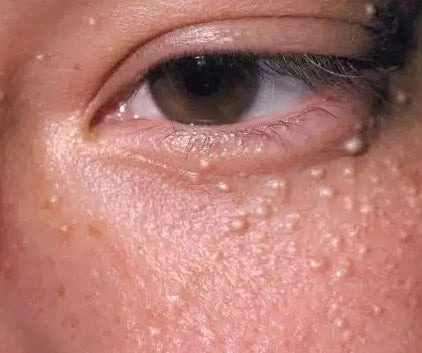Milia Treatments Restore Your Skin’s Glow
Milia, those small, hard, white bumps that often appear on the face, can be a source of frustration for many. While they are harmless and painless, they can affect your skin's appearance, making it look uneven and dull. Understanding the nature of Milia Treatments in Dubai available can help restore your skin's glow and boost your confidence. In this article, we will explore the causes of milia, effective treatment options, and tips for prevention.
Understanding Milia: What Are They?
Milia are tiny cysts that form just beneath the skin's surface. They are often mistaken for whiteheads but differ in that they are not caused by clogged pores. Instead, milia occur when keratin, a protein found in the skin, becomes trapped under the surface. This can happen for various reasons, including skin damage, sun exposure, or the use of heavy skincare products that may not allow the skin to breathe properly. Milia can appear on anyone, regardless of age or skin type, but they are particularly common in newborns, who often develop milia due to immature skin.

Effective Milia Treatments
There are several effective treatments available to help remove milia and restore your skin's glow. While some options may require professional intervention, others can be performed at home. Here are some of the most popular treatments:
1. Exfoliation
Regular exfoliation is essential for maintaining healthy skin. It helps remove dead skin cells and promotes cell turnover, reducing the chances of milia formation. You can use gentle physical exfoliants, like scrubs, or chemical exfoliants containing alpha hydroxy acids (AHAs) or beta hydroxy acids (BHAs). These ingredients help dissolve the bonds between skin cells, making it easier for trapped keratin to escape.
2. Topical Retinoids
Topical retinoids are vitamin A derivatives that promote skin cell turnover. They can help prevent and treat milia by encouraging the skin to shed its dead cells more efficiently. Products containing retinol or prescription-strength retinoids can be effective in reducing the appearance of milia and improving overall skin texture. However, it's essential to introduce retinoids gradually and monitor your skin for any signs of irritation.
3. Professional Extractions
For stubborn milia that do not respond to home treatments, seeking the help of a dermatologist or licensed skincare professional can be beneficial. They can perform extractions using specialized tools to safely remove milia without causing damage to the surrounding skin. Professional extractions ensure that milia are removed thoroughly, reducing the likelihood of recurrence.
4. Cryotherapy
Cryotherapy is a technique that involves freezing the milia with liquid nitrogen. This treatment is typically performed by a dermatologist and is effective for removing multiple milia at once. The freezing process destroys the cysts, allowing them to slough off naturally. Cryotherapy is generally quick and requires minimal downtime, making it an attractive option for those seeking immediate results.
5. Laser Treatments
Laser treatments, such as fractional laser therapy, can effectively target milia while also addressing other skin concerns like pigmentation and texture. This procedure stimulates collagen production and promotes overall skin health. While it may require multiple sessions for optimal results, laser treatments can provide long-lasting effects and help restore your skin's glow.
Home Remedies for Milia
If you prefer natural treatments, several home remedies can help manage milia. While these remedies may not guarantee the removal of milia, they can contribute to overall skin health and prevention.
1. Coconut Oil
Coconut oil is known for its moisturizing and antibacterial properties. Applying a small amount of coconut oil to the affected areas can help soften the skin and encourage the shedding of dead skin cells. Its anti-inflammatory properties may also soothe any irritation caused by milia.
2. Honey
Honey is a natural humectant that helps retain moisture in the skin. Its antibacterial properties can aid in preventing infections and promoting healing. Applying raw honey to the affected areas for 10-15 minutes before rinsing can help maintain skin health and potentially reduce milia over time.
3. Steam Treatments
Steam treatments can help open up pores and promote the release of trapped keratin. You can create a simple steam treatment at home by boiling water and allowing the steam to envelop your face for a few minutes. Follow this up with a gentle exfoliation to help remove any dead skin cells and impurities.
Prevention Tips
While treatments can help manage existing milia, taking preventive measures is essential to avoid future outbreaks. Here are some helpful tips:
1. Choose Non-Comedogenic Products
Opt for non-comedogenic skincare and makeup products that won't clog your pores. Look for labels indicating that a product is oil-free and non-acnegenic to minimize the risk of developing milia.
2. Stay Hydrated
Keeping your skin well-hydrated is crucial for maintaining its health. Drink plenty of water and use a suitable moisturizer to ensure your skin remains supple and less prone to dryness.
3. Sun Protection
Protecting your skin from harmful UV rays can prevent damage that may lead to milia. Apply sunscreen daily, even on cloudy days, and consider wearing protective clothing when spending time outdoors.
Conclusion
Milia may be a common skin concern, but with the right knowledge and treatment options, you can effectively restore your skin's glow. Whether you choose to try home remedies, seek professional help, or adopt preventive measures, taking action will help you achieve smoother, healthier skin. By understanding milia and their treatments, you can feel more confident in your skin and embrace your natural beauty.